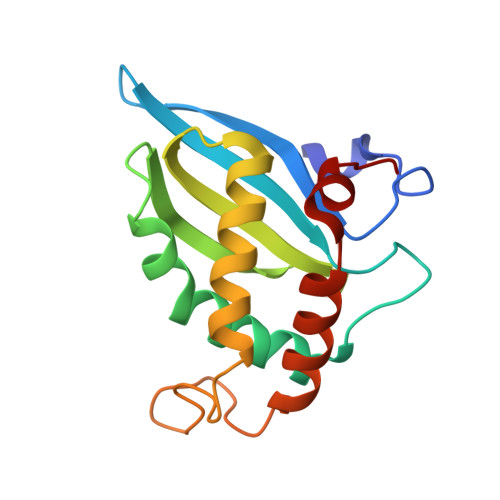Crystal Structure of S-Ribosylhomocysteinase (LuxS) in Complex with a Catalytic 2-Ketone Intermediate.
Rajan, R., Zhu, J., Hu, X., Pei, D., Bell, C.E.(2005) Biochemistry 44: 3745-3753
- PubMed: 15751951
- DOI: https://doi.org/10.1021/bi0477384
- Primary Citation of Related Structures:
1YCL - PubMed Abstract:
S-Ribosylhomocysteinase (LuxS) is an Fe(2+)-dependent metalloenzyme that catalyzes the cleavage of the thioether bond in S-ribosylhomocysteine (SRH) to produce homocysteine (Hcys) and 4,5-dihydroxy-2,3-pentanedione (DPD), the precursor of type II bacterial quorum-sensing molecule. The proposed mechanism involves an initial metal-catalyzed aldose-ketose isomerization reaction, which results in the migration of the ribose carbonyl group from its C1 to C2 position and the formation of a 2-ketone intermediate. A repetition of the isomerization reaction shifts the carbonyl group to the C3 position. Subsequent beta-elimination reaction at the C4 and C5 positions completes the catalytic cycle. In this work, a catalytically inactive mutant (C84A) of Co(2+)-substituted Bacillus subtilis LuxS was cocrystallized with the 2-ketone intermediate and the structure was determined to 1.8 A resolution. The structure reveals that the C2 carbonyl oxygen is directly coordinated with the metal ion, providing strong support for the proposed Lewis acid function of the metal ion during catalysis. Cys-84 and Glu-57 are optimally positioned to act as general acids/bases during the isomerization and elimination reactions. In addition, Ser-6, His-11, and Arg-39 are involved in substrate/ intermediate binding through hydrogen bonding interactions. The above conclusions are further confirmed by site-directed mutagenesis and visible absorption spectroscopic studies.
Organizational Affiliation:
Department of Molecular and Cellular Biochemistry, Biophysics Program, The Ohio State University, Columbus, Ohio 43210, USA.

















